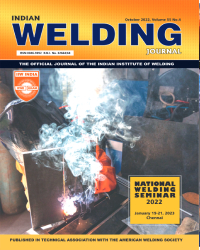Microstructure Evolution and Bonding Strength of Brazed Joint of Stainless Steel and Copper
Subscribe/Renew Journal
The joining behaviour between stainless steel and copper has an importance in scientific and engineering applications such as high energy ring vacuum chambers and International Thermonuclear Fusion Experiment Reactor (ITER). In this research, the rapidly solidified foils of nominal composition 50Cu-40Mn-10Ni (C50) are used as a filler alloy for brazing between stainless steel (304 SS) and copper (Cu) plates. It is examined that C50 foil makes a good contact joint between two dissimilar metal plates of different thermal conductivities. The brazed region is mostly free from any porosities and intermetallic compounds, emphasizing on the distribution of solid solution phases. It causes high bonding strength of 304 SS-Cu butt joint at low brazing temperature (BT=920°C) with a fracture at the joint area. On the other hand, the fracture occurs at Cu base metal for BT = 980°C. The fractography also shows the presence of several dimples at Cu substrate and severely deformed region at stainless steel substrate, representing a good quality bonding between 304SS and Cu plates.
Keywords
Brazing, Diffusion, Electron Microscopy, Solid Solution Phases, Bonding Strength.
User
Subscription
Login to verify subscription
Font Size
Information

Abstract Views: 458

PDF Views: 4



